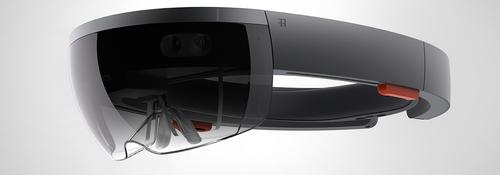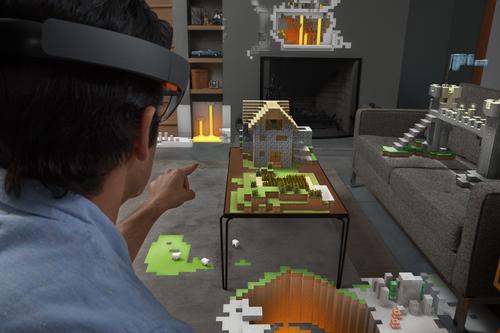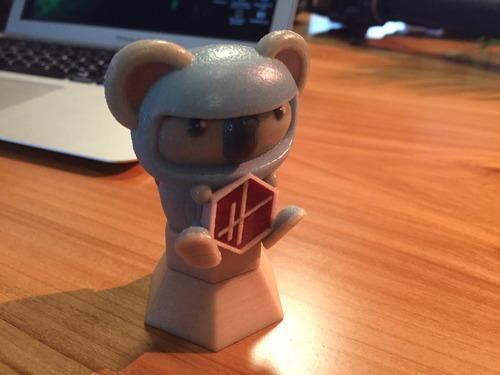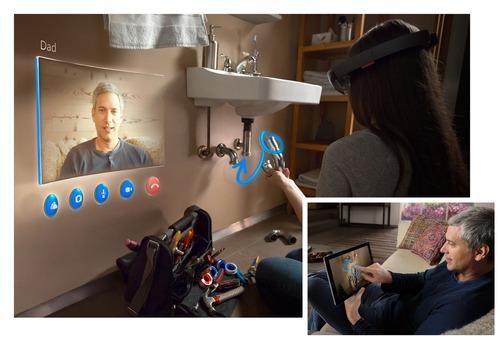Thank you, Microsoft. Thank you for throwing a crazy augmented reality announcement into a standard operating system event. Thanks for thumbing your nose at Google (which just gave up on the first version of Google Glass), and showing us Microsoft HoloLens. It is surely the most unexpected announcement to come out of Microsoft in years — maybe ever.
 (Photo: Microsoft)
(Photo: Microsoft)
HoloLens is the hardware side of Microsoft’s other big Windows A.R. announcement: Windows Holographic. This is the new addition toWindows 10 that allows it to understand the shape and location of objects in the real world so it can project virtual objects on top of them.
HoloLens, the hardware, is the way you see these objects. The HoloLens hardware is a wireless visual headset with transparent lenses that allow you to see the world in front of you, while an image is simultaneously projected on top of what you see.
Unlike Google Glass, which puts a little image off to the edge of your field of vision, HoloLens can project images over almost all of it. And unlike the Oculus Rift, which is an immersive virtual reality system that blocks out the real world, HoloLens includes it.
For more great tech news and reviews, follow Yahoo Tech on Facebook!
We were given demos of HoloLens hardware, but not on the fancy, slick, hardware that Microsoft showed on stage at the Windows 10 announcement (see picture). Rather, our demos were on two-piece contraptions that included a computer that hung around your neck like binoculars, a mad-scientist headset that ratcheted down onto your head with ominous clicks, and a thick wire connecting it to an off-board mystery box somewhere. Microsoft did not allow us to take pictures of these contraptions; in fact, they made us lock our phones in gym lockers for the HoloLens demos.
Nonetheless, the demos were sweet.
Minecraft in walls
Demo 1: I put on the HoloLens for the first time. A frame appears in front of me, about the size of a 50-inch HDTV at 10 feet, or perhaps an iPad at half arm’s length. I can see right through it. That is, until I look at a coffee table in the room. On that table, which in the real world has nothing on it, there appears a Minecraft tower and a bunch of blocks. There’s a hole in the table. I move over the table and can peer through the hole to the Minecraft world below.
Demo 1: I put on the HoloLens for the first time. A frame appears in front of me, about the size of a 50-inch HDTV at 10 feet, or perhaps an iPad at half arm’s length. I can see right through it. That is, until I look at a coffee table in the room. On that table, which in the real world has nothing on it, there appears a Minecraft tower and a bunch of blocks. There’s a hole in the table. I move over the table and can peer through the hole to the Minecraft world below.

On a credenza nearby, there are a bunch of nasty zombies. I “air click” on the surface (look at a spot on the table and make a clicking motion with my finger) and open up a hole in their world. I click on TNT to explode their land. They fall into lava below. Poor zombies.
HoloLens has a feature that scans the room to know where the surfaces are. But we were told not to nudge the tables in this demo out of place or it would lose that registration.
Still … coolest demo ever.
MS Paint in 3D … sort of
In the next demo, we watched but did not drive. We saw a presenter’s-eye view of building a toy truck in 3D, using a virtual, floating toolbox of items. The presenter was able to move around the truck, and usinggestures and voice, to add wheels and a hood ornament to it. Then, he said, he could send it to a 3D printer. He showed us a prebuilt model of what the printed truck would look like, and we all got little 3D-printed koala bears holding USB sticks with the HoloLens press kit. Pretty cute.
In the next demo, we watched but did not drive. We saw a presenter’s-eye view of building a toy truck in 3D, using a virtual, floating toolbox of items. The presenter was able to move around the truck, and usinggestures and voice, to add wheels and a hood ornament to it. Then, he said, he could send it to a 3D printer. He showed us a prebuilt model of what the printed truck would look like, and we all got little 3D-printed koala bears holding USB sticks with the HoloLens press kit. Pretty cute.

Mr. Koala hides a USB memory stick. (Photo: Yahoo Tech)
Mars in your officeMicrosoft is collaborating with the Jet Propulsion Lab to build an augmented reality toolkit for scientists and engineers working on controlling the Mars rover. In the demo, I put on the headset, and the office walls melted away — except for the desk and the computer on it — and I could see Mars as if I was standing on the planet’s surface. I could walk around and gauge the size of rocks, with the giant Curiosity rover in the room alongside me.
Later in the demo, a collaborator beamed in (he showed up as a golden torso) and we worked together to tag a few rocks for further study or vaporization (the rover has a science laser on it). We talked to each other clearly and the system showed us where the other person was looking. It made interplanetary collaboration look easy.
Augmented Skype
Finally, I got the Skype demo. I was tasked with installing a light switch in a room with bare wires sticking out a wall. A nice man popped into my field of view and talked me through the process. He could see what I was looking at and was able to draw images and diagrams on the wall for me.
Finally, I got the Skype demo. I was tasked with installing a light switch in a room with bare wires sticking out a wall. A nice man popped into my field of view and talked me through the process. He could see what I was looking at and was able to draw images and diagrams on the wall for me.

This was a great demo of how augmented reality could be a huge help for instruction. Forget light switches. Think fixing jet engines or teaching surgery — examples where students or institutions are far more likely to pony up for what is probably going to be a very expensive piece of hardware.
When? For whom? How much?
And there’s the snag. Microsoft did not give date for the release of this hardware, other than “in the Windows 10 timeframe,” which is ridiculously vague. No pricing, either.
And there’s the snag. Microsoft did not give date for the release of this hardware, other than “in the Windows 10 timeframe,” which is ridiculously vague. No pricing, either.
As a tool for industry and science, the HoloLens seems like a slam dunk. The hardware looks sleek enough to not get in the way too much, and it will be self-contained; you won’t need to connect it to anything to work. I would expect corporate developers to drool over Microsoft’s holographic hardware and software.
For consumers, though, the outlook is not as clear. Microsoft has experimented with blending the digital and physical worlds with the Xbox Kinect, and the prospects for even that highly consumer-focused product seem to be dwindling. The “father of Kinect,” Alex Kipman, is now the man for HoloLens. We’ll see if he has more success with this much more audacious project.
HoloLens and Windows Holographic are a platform, not products that exist by themselves. They will require developers to get on board. For consumers, that means games developers. We’re going to be on the lookout for studios that want to build these augmented reality games, and hope (really hope) we can tell you about their projects soon.
And to be super clear about this: HoloLens is not a product designed to be worn “in the world.” It’s a tool for playing games or performing brain surgery. It’s not Google Glass. But when we get augmented reality hardware that’s small and unobtrusive — contact lenses, perhaps — then we’ll begin to see people walk around in a fully augmented world.
Until then, we’ve got experiments like this, where risk-taking developers build technically amazing projects for small numbers of people who really, really want (or need) to blend the real and digital worlds.
It is inevitable this technology will be part of our future. This is just one of the first steps. LINK


